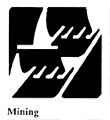|
Mining
 Issues Issues
- Management of the resource base, ie
- land access
- efficiency in extraction and use
- R&D strategies
- community returns competitiveness
- Management of the environmental, economic and social
impacts of exploitation of the resource base
- decision making process
- minimisation and monitoring of environmental
impacts, Aboriginal aspects, regulation of extraction
industries, eg. sand, gravel
- 'Greenhouse' aspects
- environmental valuations
Summary of Final Report
The mining and minerals processing industries are major
sources of Australia's export income; most of our consumer
goods are made from, or are packaged in, products from the
mining sector; mining is also an important basis for
regional development and employment.
By their nature mining activities involve some degree of
environmental disturbance, with potential implications for
ecological systems and biodiversity. Processing of minerals
can have a more substantial effect by generating pollution,
including toxic wastes. The coal industry (as a major
supplier to the electricity industry) and the mineral
processing industry (as a major consumer of electricity)
indirectly make a substantial contribution to greenhouse gas
emissions.
The issue of potential climate change particularly
concerns the coal industry, which is individually
Australia's major export industry.
Competition between industry and conservation interests
for particular areas of land has been intensifying in recent
years and is likely to increase in the future. Mining has
also often been at the edge of interaction between economic
development and Aboriginal communities and culture and the
question of land rights for Australian Aborigines.
The overall objective of the ESD process is to ensure
compatibility between mining development and the
environment. Where trade-offs can be avoided, they should
be; where they cannot, decisions should be based on as
complete an understanding as possible of the environmental,
economic and social factors involved.
The theme of this report is the need to integrate
environmental and social factors into decision making about
economic development. Additionally the Working Group
considered the following:
- achieving efficient mining development, appropriate
community returns and improved land-use planning and
decisionmaking processes;
- achieving better environmental protection and
management;
- responding effectively to global environmental and
economic challenges;
- improving and making better use of information
through R&D and public involvement;
- improving performance in occupational health and
safety; and
- achieving social equity goals.
The Working Group also considered ways for ensuring that
environmental resources are appropriately valued, accepting
that the best approach will usually involve a combination of
market-based mechanisms and regulation.
Eighty-eight recommendations have been made by the
Working Group most of which relate to proposed government
actions. Some, however, are directed at individual firms and
at industry associations, some at unions and environmental
and other non-government organisations and some at the
sector as a whole.
Key recommendations:
- further research on market-based options to
facilitate decision making in the mining sector including
security bonds for mine rehabilitation which provide
incentives for improved environmental performance;
tradable pollution rights for mines or processing plants;
penalties and fines for poor environmental performance
linked directly to level of emissions or environmental
damage; ways of assigning monetary value to non-economic
environmental resources, such as aesthetic values.
community returns:
- governments progressively replace pseudo royalties,
such as excessive transport costs and the coal export
levy, with more transparent, efficient and direct
method.s for collecting community returns
improving land-use planning & decision
making:
- the Australia and New Zealand Environment and Conservation Council
(ANZECC) immediately undertake to review and clarify existing land
classifications tor the entire Australian land mass to improve the
general level of knowledge ahout land and current land uses, and to
help governments take decisions about future land uses as particular
proposals for change come forward. This review should be under-taken
in close consultation with other appropriate Ministerial Councils
such as the Australian and New Zealand Minerals and Energy council,
and be open for public scrutiny;
- governments ensure that land-use guidelines are available to indicate
whether and under what circumstances, mineral exploration and mining
activities would be acceptable for various land-use categories;
- ANZECC to develop a national framework to guide the future development
of the conservation estate in Australia, including regional planning
with biogeographic regions not being limited by State or Territory
borders;
- the process for identification and protection of and availability
of information on, sites of special significance to Aborigines be
agreed between the States and Territories and the Commonwealth, in
a manner that satisfies the interests of Aborigines and the mining
industry;
- mining industry and Aboriginal interests to improve
consultation processes.
better environmental management:
- governments articulate and publicise their
objectives, policies and requirements for environmental
management of exploration and mining activities;
- environmental management be treated as an integral
component of the decision-making and regulatory process
in relation to exploration and mining;
- companies be required to lodge security bonds or
similar financial instruments to ensure that the cost of
rehabilitation of mine sites can be met by the miner
rather than through public funding.
The Working Group also makes recommendations on
greenhouse, R&D, improving the contribution of mining
communities and the workforce, community consultation and
public information, and ways of adapting institutions to an
ESD world.
Source: ESD Newsbrief, No 5, December 1991
Back...

|
 Issues
Issues